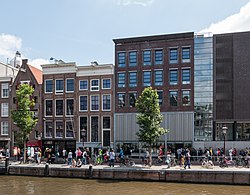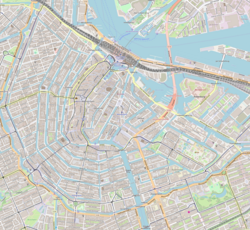 Canal house and museum entrance in 2015 (has black facade at ground level) | |
Location in the city centre of Amsterdam | |
| Established | 3 May 1960 |
|---|---|
| Location | Prinsengracht 263-267[1] Amsterdam, Netherlands |
| Coordinates | 52°22′31″N 4°53′04″E / 52.37525°N 4.88432°E |
| Type | Biographical museum Historic house museum |
| Visitors | 1.2 million (2023)[2] |
| Founder | Otto Frank[3] |
| Director | Ronald Leopold[4] |
| President | Wim Kok[4] |
| Public transit access | Westermarkt[1] Trams lines: 13, 14, 17[1] Bus lines: 170, 172, 174[1] |
| Website | www |
The Anne Frank House (Dutch: Anne Frank Huis) is a writer's house and biographical museum dedicated to Jewish wartime diarist Anne Frank. The building is located on a canal called the Prinsengracht, close to the Westerkerk, in central Amsterdam in the Netherlands.
During World War II, when the Netherlands was occupied by Germany, Anne Frank hid from Nazi persecution with her family and four other people in hidden rooms, in the rear building, of the 17th-century canal house, later known as the Secret Annex (Dutch: Achterhuis). She did not survive the war but her wartime diary was published in 1947. Ten years later the Anne Frank Foundation was established to protect the property from developers who wanted to demolish the block.
The entire museum, which occupies the three adjacent buildings on the street front of Prinsengracht 263 to 267,[1] opened on 3 May 1960. It preserves the hiding place (the Secret Annex at rear of 263), with the other buildings expanding the permanent exhibition on the life and times of Anne Frank, and has an exhibition space about all forms of persecution and discrimination. In 2017, the museum had 1.27 million visitors and was the third most visited museum in the Netherlands, after the Van Gogh Museum and the Rijksmuseum.
- ^ a b c d e Opening hours, prices, location, Anne Frank House. Retrieved 11 July 2014.
- ^ "Annual Report 2023". annefrank.org. Anne Frank House. Retrieved 2 September 2024.
- ^ Saved from demolition, Anne Frank House. Retrieved 11 July 2014.
- ^ a b Management Archived 23 September 2015 at the Wayback Machine, Anne Frank House. Retrieved 11 July 2014.
